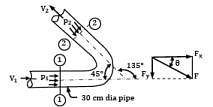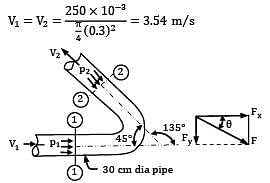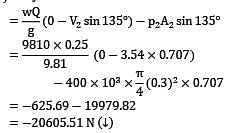Civil Engineering (CE) Exam > Civil Engineering (CE) Questions > Water is flowing at a rate of 250 lt/sec. th...
Start Learning for Free
Water is flowing at a rate of 250 lt/sec. through a pipe of 30 cm diameter. If the pipe is bent by 135°, find the magnitude and direction of resultant force on the bend. The pressure of water flowing in the pipe is 400 kPa.

- a)F = 53.6 kN; θ = 22.5°
- b)F = 22.5 kN; θ = 53.6°
- c)F = 49.75 kN; θ = 22.5°
- d)F = 20.6 kN; θ = 35.6°
Correct answer is option 'A'. Can you explain this answer?
| FREE This question is part of | Download PDF Attempt this Test |
Verified Answer
Water is flowing at a rate of 250 lt/sec. through a pipe of 30 cm dia...
The pipe is of uniform cross sectional area. Therefore, the flow velocities at section 1-1 and section 2-2 are the same.




View all questions of this test

The pressure intensity is also the same at the two sections.
P1 = P2 = 400 kPa = 400 × 103 N⁄m2
Based on forces on pipe bends Force along the x-axis (on the pipe): Fx = dynamic force + static force

Force along the y -axis (on the pipe):
Fy = dynamic force + static force

Magnitude of resultant force on the bend is

And the direction of resultant force with x-axis is

An equal and opposite force will be required to hold the duct in position.
Note: That any particle in a free liquid jet experiences gravitational forces only and thus it can be solved as a projectile.
Most Upvoted Answer
Water is flowing at a rate of 250 lt/sec. through a pipe of 30 cm dia...
The pipe is of uniform cross sectional area. Therefore, the flow velocities at section 1-1 and section 2-2 are the same.





The pressure intensity is also the same at the two sections.
P1 = P2 = 400 kPa = 400 × 103 N⁄m2
Based on forces on pipe bends Force along the x-axis (on the pipe): Fx = dynamic force + static force

Force along the y -axis (on the pipe):
Fy = dynamic force + static force

Magnitude of resultant force on the bend is

And the direction of resultant force with x-axis is

An equal and opposite force will be required to hold the duct in position.
Note: That any particle in a free liquid jet experiences gravitational forces only and thus it can be solved as a projectile.
Free Test
FREE
| Start Free Test |
Community Answer
Water is flowing at a rate of 250 lt/sec. through a pipe of 30 cm dia...
The pipe is of uniform cross sectional area. Therefore, the flow velocities at section 1-1 and section 2-2 are the same.





The pressure intensity is also the same at the two sections.
P1 = P2 = 400 kPa = 400 × 103 N⁄m2
Based on forces on pipe bends Force along the x-axis (on the pipe): Fx = dynamic force + static force

Force along the y -axis (on the pipe):
Fy = dynamic force + static force

Magnitude of resultant force on the bend is

And the direction of resultant force with x-axis is

An equal and opposite force will be required to hold the duct in position.
Note: That any particle in a free liquid jet experiences gravitational forces only and thus it can be solved as a projectile.
Attention Civil Engineering (CE) Students!
To make sure you are not studying endlessly, EduRev has designed Civil Engineering (CE) study material, with Structured Courses, Videos, & Test Series. Plus get personalized analysis, doubt solving and improvement plans to achieve a great score in Civil Engineering (CE).

|
Explore Courses for Civil Engineering (CE) exam
|

|
Similar Civil Engineering (CE) Doubts
Water is flowing at a rate of 250 lt/sec. through a pipe of 30 cm diameter. If the pipe is bent by 135°, find the magnitude and direction of resultant force on the bend. The pressure of water flowing in the pipe is 400 kPa.a) F = 53.6 kN; θ = 22.5°b) F = 22.5 kN; θ = 53.6°c) F = 49.75 kN; θ = 22.5°d) F = 20.6 kN; θ = 35.6°Correct answer is option 'A'. Can you explain this answer?
Question Description
Water is flowing at a rate of 250 lt/sec. through a pipe of 30 cm diameter. If the pipe is bent by 135°, find the magnitude and direction of resultant force on the bend. The pressure of water flowing in the pipe is 400 kPa.a) F = 53.6 kN; θ = 22.5°b) F = 22.5 kN; θ = 53.6°c) F = 49.75 kN; θ = 22.5°d) F = 20.6 kN; θ = 35.6°Correct answer is option 'A'. Can you explain this answer? for Civil Engineering (CE) 2024 is part of Civil Engineering (CE) preparation. The Question and answers have been prepared according to the Civil Engineering (CE) exam syllabus. Information about Water is flowing at a rate of 250 lt/sec. through a pipe of 30 cm diameter. If the pipe is bent by 135°, find the magnitude and direction of resultant force on the bend. The pressure of water flowing in the pipe is 400 kPa.a) F = 53.6 kN; θ = 22.5°b) F = 22.5 kN; θ = 53.6°c) F = 49.75 kN; θ = 22.5°d) F = 20.6 kN; θ = 35.6°Correct answer is option 'A'. Can you explain this answer? covers all topics & solutions for Civil Engineering (CE) 2024 Exam. Find important definitions, questions, meanings, examples, exercises and tests below for Water is flowing at a rate of 250 lt/sec. through a pipe of 30 cm diameter. If the pipe is bent by 135°, find the magnitude and direction of resultant force on the bend. The pressure of water flowing in the pipe is 400 kPa.a) F = 53.6 kN; θ = 22.5°b) F = 22.5 kN; θ = 53.6°c) F = 49.75 kN; θ = 22.5°d) F = 20.6 kN; θ = 35.6°Correct answer is option 'A'. Can you explain this answer?.
Water is flowing at a rate of 250 lt/sec. through a pipe of 30 cm diameter. If the pipe is bent by 135°, find the magnitude and direction of resultant force on the bend. The pressure of water flowing in the pipe is 400 kPa.a) F = 53.6 kN; θ = 22.5°b) F = 22.5 kN; θ = 53.6°c) F = 49.75 kN; θ = 22.5°d) F = 20.6 kN; θ = 35.6°Correct answer is option 'A'. Can you explain this answer? for Civil Engineering (CE) 2024 is part of Civil Engineering (CE) preparation. The Question and answers have been prepared according to the Civil Engineering (CE) exam syllabus. Information about Water is flowing at a rate of 250 lt/sec. through a pipe of 30 cm diameter. If the pipe is bent by 135°, find the magnitude and direction of resultant force on the bend. The pressure of water flowing in the pipe is 400 kPa.a) F = 53.6 kN; θ = 22.5°b) F = 22.5 kN; θ = 53.6°c) F = 49.75 kN; θ = 22.5°d) F = 20.6 kN; θ = 35.6°Correct answer is option 'A'. Can you explain this answer? covers all topics & solutions for Civil Engineering (CE) 2024 Exam. Find important definitions, questions, meanings, examples, exercises and tests below for Water is flowing at a rate of 250 lt/sec. through a pipe of 30 cm diameter. If the pipe is bent by 135°, find the magnitude and direction of resultant force on the bend. The pressure of water flowing in the pipe is 400 kPa.a) F = 53.6 kN; θ = 22.5°b) F = 22.5 kN; θ = 53.6°c) F = 49.75 kN; θ = 22.5°d) F = 20.6 kN; θ = 35.6°Correct answer is option 'A'. Can you explain this answer?.
Solutions for Water is flowing at a rate of 250 lt/sec. through a pipe of 30 cm diameter. If the pipe is bent by 135°, find the magnitude and direction of resultant force on the bend. The pressure of water flowing in the pipe is 400 kPa.a) F = 53.6 kN; θ = 22.5°b) F = 22.5 kN; θ = 53.6°c) F = 49.75 kN; θ = 22.5°d) F = 20.6 kN; θ = 35.6°Correct answer is option 'A'. Can you explain this answer? in English & in Hindi are available as part of our courses for Civil Engineering (CE).
Download more important topics, notes, lectures and mock test series for Civil Engineering (CE) Exam by signing up for free.
Here you can find the meaning of Water is flowing at a rate of 250 lt/sec. through a pipe of 30 cm diameter. If the pipe is bent by 135°, find the magnitude and direction of resultant force on the bend. The pressure of water flowing in the pipe is 400 kPa.a) F = 53.6 kN; θ = 22.5°b) F = 22.5 kN; θ = 53.6°c) F = 49.75 kN; θ = 22.5°d) F = 20.6 kN; θ = 35.6°Correct answer is option 'A'. Can you explain this answer? defined & explained in the simplest way possible. Besides giving the explanation of
Water is flowing at a rate of 250 lt/sec. through a pipe of 30 cm diameter. If the pipe is bent by 135°, find the magnitude and direction of resultant force on the bend. The pressure of water flowing in the pipe is 400 kPa.a) F = 53.6 kN; θ = 22.5°b) F = 22.5 kN; θ = 53.6°c) F = 49.75 kN; θ = 22.5°d) F = 20.6 kN; θ = 35.6°Correct answer is option 'A'. Can you explain this answer?, a detailed solution for Water is flowing at a rate of 250 lt/sec. through a pipe of 30 cm diameter. If the pipe is bent by 135°, find the magnitude and direction of resultant force on the bend. The pressure of water flowing in the pipe is 400 kPa.a) F = 53.6 kN; θ = 22.5°b) F = 22.5 kN; θ = 53.6°c) F = 49.75 kN; θ = 22.5°d) F = 20.6 kN; θ = 35.6°Correct answer is option 'A'. Can you explain this answer? has been provided alongside types of Water is flowing at a rate of 250 lt/sec. through a pipe of 30 cm diameter. If the pipe is bent by 135°, find the magnitude and direction of resultant force on the bend. The pressure of water flowing in the pipe is 400 kPa.a) F = 53.6 kN; θ = 22.5°b) F = 22.5 kN; θ = 53.6°c) F = 49.75 kN; θ = 22.5°d) F = 20.6 kN; θ = 35.6°Correct answer is option 'A'. Can you explain this answer? theory, EduRev gives you an
ample number of questions to practice Water is flowing at a rate of 250 lt/sec. through a pipe of 30 cm diameter. If the pipe is bent by 135°, find the magnitude and direction of resultant force on the bend. The pressure of water flowing in the pipe is 400 kPa.a) F = 53.6 kN; θ = 22.5°b) F = 22.5 kN; θ = 53.6°c) F = 49.75 kN; θ = 22.5°d) F = 20.6 kN; θ = 35.6°Correct answer is option 'A'. Can you explain this answer? tests, examples and also practice Civil Engineering (CE) tests.

|
Explore Courses for Civil Engineering (CE) exam
|

|
Suggested Free Tests
Signup for Free!
Signup to see your scores go up within 7 days! Learn & Practice with 1000+ FREE Notes, Videos & Tests.
























